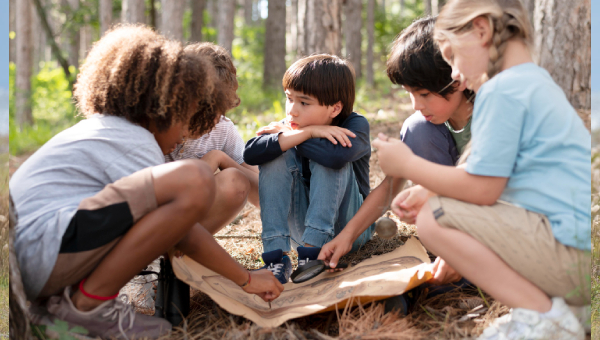Tiny Bites, Mighty Nutrition: Power-Packed Solids for Your Baby
Learning Through Nature: Outdoor Education Activities for Children

While the world today is dominated by screens, the opportunity children have, to freely play and learn outside will always be essential. Outdoor learning integrates movement and fun with specific tasks and goals and enables children to develop a deeply imaginative and physically robust sense of inquiry grounded in nature. Such activities do not only educate children on the nature aspect, but also interfere with cognitive gains, social and psychological profiles, and physical development that is usually not well captured in traditional learning that takes place indoors. Now, let’s talk about the advantages of outdoor education and several activities that will be useful for children.
Why Outdoor Education Matters
There are several advantages in behalf of outdoor learning. They improve physical health, keep off stress and help in solving problems while at the same time getting crusader of environmental issues at large for the kids. The evaluative contingency of the natural environment also promotes more practical engagement and improves children’s attentiveness, curiosity, and reasoning abilities. The following are some core benefits that assist in students’ performance improvements.
- Enhanced Physical Development: Climbing, running, and balancing on slopes and hills develop a child's physical strength, coordination, and gross motor skills. This type of activity helps children get exercise and increases their health standards.
- Improved Cognitive Skills: Practically all outdoor games entail the stunt of creating out of a box and thus exercising their creativity. Children have to know how to get on a tree without falling, recognize plants, or construct a shelter which means cognition skills are developed.
- Emotional Resilience: From nature, children get settings that they don’t organize on their own. Our desire for them to develop adventure, challenge and love for nature kept pushing them to be more creative and face small challenges like getting dirty or attempting to construct something using bare hands. This creates self-confidence and alumni resilience.
- Social Development: Physical activities that include racing into a house, crawling under a table, and catching a ball entail teaming and even communication thereby improving the social intelligence of children and empathy. In group tasks, they understand how to follow other people and be followed, accept different ideas, and to be accepted and that in turn increases their prowess in cooperation.
- Environmental Stewardship: Learning to respect the environment can do more than just teach a person what’s and is not okay, it builds an appreciation of the environment, which can start at a young age if a person spends some of his/her summer vacations in the wilderness. If children wander into forests, lakes, and fields, they develop their own bond with these places and it becomes their own business to ensure they preserve the environment.
Creative Outdoor Learning for the Kids
Below are some fun activities you can incorporate when taking children on outdoor education while attempting to pass on several important skills. These activities can be used with older or young people and may occur in backyards, parks as well as in the wild.
Nature Scavenger Hunt
A nature scavenger hunt is a noteworthy and engaging way for children to look at the world around them. Make a list of things they have to look for in nature and then have them look for a pine cone, a feather, a smooth stone or an unusual-shaped leaf. As they look for these items, children use lookout skills and gain knowledge of various plant species and animals in the environment. As an educational turn, there should be questions or clues for every item. For example, instead of mere ‘locate a feather’ try it as ‘locate a feather and try and deduce which bird might have shed the mentioned feather’. Eventually, you can talk to the children about what they have found and further explain to them some information about the plants or animals that they identified.
Identification of Bird species
Birdwatching is a rather silent activity and the main purpose that children accept with pleasure is to wait and observe. I suggest giving kids a small guide or an application that describes anything that a child can meet on birds in the wild. Take binoculars and let them learn how to differentiate birds at a certain distance, via size, colour or sound.
They further note that through their observations students may learn the behavior of birds in terms of feeding; their eating habits; matters relating to avian habitats; and issues of migration. This activity also has an environmental advancement since children learn about ecosystems sustaining animals in the locality.
Building a Shelter
When constructing a shelter, children learn about survival, creativity and how highly important teamwork is. With sticks, leaves, and rocks children can attempt to build a shelter that in theory could accommodate and protect a child and keep him or her dry. Such activity enhances proactivity and cooperation since they have to work out how to design a structure with limited resources only. You can talk to the children about how it is necessary to add the proper structure, balance, and stability. Also, respect for what is around us: they know how to use materials that negatively affect the environment.
Tracking Animal Prints
One of the best methods to introduce children to the fauna of their region is tracking animal prints. You can take a guidebook along to point out the patterns on the sand and then try to figure out which animal might have left the marks. Children can identify one another by the size, the shape, and the pattern which the track makes. This activity exposes the children to different animals they cannot see during the day, and learn about them and their habits, food and habitat and the food Chain. Furthermore, tracking entails a lot of time and focus, which develops strength since they keenly follow the movements of the children they are tasked with monitoring.
Plant Identification and Botany Basics
Teaching children about plants could be such a fulfilling method of introducing them to the subject of botany. Begin with a few simple plants, flowers or trees, and show children that they should collect them by the type of their leaves, roughness or the smell they emit. If possible, allow them to make contact with the plants, for touch and smell are important requisites that can remind the children what they learned. For the elder children, you can educate them on functions such as photosynthesis, pollination, and seed distribution. Evaluating and developing children’s ability to distinguish and accept plants gives them knowledge of respecting nature and the function of plants.
Fishing in Ponds and Waterways
Pond dipping can be a fun activity especially if there is a water basin or running water nearby. Let children cover their hands with nets and containers; make them use gentle hands to catch water creatures such as tadpoles, insects or tiny fishes. Children should also free the creatures used and animals after the exercise to avoid interfering with their habitat.
According to the present activity, certain children can learn about aquatic environments, and the concept of species diversity, as well as learn about the life cycles of various creatures. This kind of observation can also help inculcate in the children the aspect of water quality and ecological systems.
Nature Journaling
Another productive learning activity can be persuading the children to begin using a nature journal as an exciting blend of art and science. Hand them notebooks and let them draw or write any observation they have on what they notice, hear or even feel when outside. They can paint a picture of them as leaves and even make an impression of the trunk of a tree, or list all the sounds made by various birds. It improves attitudes toward nature, productivity and concentration through journaling. It also allows children to express themselves more and work on a writing or drawing project. As a result, as the students continue to use them, the meant journals transform into documentation of their outdoor activities and acquisitions.
Rules for Parents and Teachers
Recreation is best done outside the four walls of a house, but the tasks should be well organized to ensure that there are no incidences in the course of the exercise, the children should also be observed while learning. Here are some tips to make these experiences successful:
- Safety First: Safety should always be checked for any danger. Look for poisonous plants, beehives or a place where a child could easily twist his ankle. Always take a simple first aid kit with you, and please make sure that kids dress properly and wear suitable shoes when going out.
- Foster Respect for Nature: Let children know how to respect nature and its diverse parts. It was proposed that they should never disturb rocks, flowers or creatures which they might find during their tours. It is quite simple, just like the slogan ‘So you take nothing but pictures, leave nothing but footprints and take nothing but memories, leave nothing but footprints,’ such helps to teach children to respect the environment.
- Embrace the Elements: Forget a few muddy legs or a cold wet day. For children to be strong and adapt to the changing weather; it is necessary that they spend most of their time outdoors no matter the prevailing weather conditions. Just be sure they’re dressed correctly for the climate.
- Reflect and Discuss: Suggested that after each activity there should be a brief discussion in which kids are encouraged to share what new information they got or what amazed them and which activity they liked most. This then cements what they have learned and also allows them to express what they have gone through.
Conclusion
Outdoor learning plays an important part in enriching children’s daily habits as well as in the acquisition of such crucial life experiences. Such outdoor activities enhance learning, appreciation, and discovery of the environment, and other aspects they will be relieved of throughout their adulthood. Teaching children through nature may be considered a wise investment—the future stewards of this Earth. Taking children outside provides more than much-needed fresh air and a bit of running around but endless possibilities to learn and develop holistically.
MUST READ: How AI is Redefining Personalized Learning in Modern Classrooms








